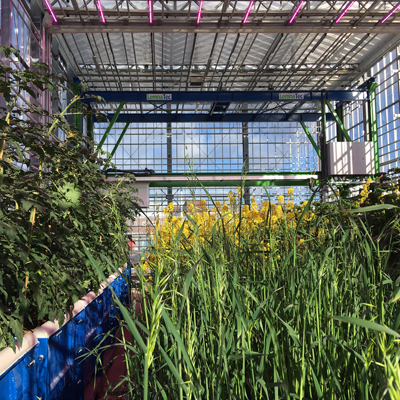At a glance
- DatesNovember 2012 – continuing
- SponsorBiotechnology and Biological Sciences Research Council (BBSRC), Department for International Development (DFID), Bill & Melinda Gates Foundation (BMGF)
- Funded£325,427 (£1m in total)
- PartnersInternational Rice Research Institute (Philippines), Japan International Research Centre for Agricultural Science (JIRCAS), Imperial College London, University of Southampton
Projects:
- Rice germplasm for high grain zinc content and tolerance of zinc deficient soils. (BBSRC BB/J011584/1)
- Metal contamination of rice supplies in Asia (BBSRC BB/P02274X/1)
Zinc (Zn) deficiencies limit crop production in many parts of the world, and Zn is often deficient in the diet of humans subsisting on staple-food crops such as rice. An important strategy for dealing with this is to breed crops that are efficient in taking up Zn and concentrating it in edible plant parts. Zinc deficiency is a particular problem in rice because of the chemistry of submerged rice paddy soils, which results in Zn being extremely insoluble in many rice soils and therefore hard for the plants to take up.
This research aims to understand the mechanisms of Zn uptake by rice, and so to develop varieties both tolerant of Zn-deficient soils and with increased grain zinc. It involves field work in the Philippines and Bangladesh, and controlled-environment and mathematical modelling experiments at Cranfield.
A follow-on project is investigating the extent of contamination of rice supplies across Asia with toxic contaminants, particularly cadmium and arsenic, and whether rice varieties with enhanced Zn uptake also take up toxic contaminants.
Publications:
Affholder M.C., Weiss, D.J., Wissuwa M., Johnson-Beebout S. & Kirk G.J.D. (2017) Soil CO2 venting as one of the mechanisms for tolerance of Zn deficiency by rice in flooded soils. Plant Cell Environ., 40, 3018–3030, doi: 10.1111/pce.13069.Marković T., Manzoor S., Williams E., Kirk G.J.D., Vilar R.& Weiss D.J. (2017) Experimental determination of equilibrium zinc isotopic fractionation in complexes with the phytosiderophore 2’-deoxymugeneic acid and its structural analogues, and implications for plant uptake mechanisms. Environ. Sci. Technol., 58, 98–107. doi:10.1021/acs.est.6b00566.
Mori A., Kirk G.J.D., Lee J.S., Morete M.J., Nanda A.K., Johnson-Beebout S.E. & Wissuwa M. (2016) Rice genotype differences in tolerance of zinc-deficient soils: evidence for the importance of root-induced changes in the rhizosphere. Front. Plant Sci., 6, 1160. doi:10.3389/fpls.2015.01160
Izquierdo M., Impa S.M., Johnson-Beebout S.E., Weiss D.J. & Kirk G J.D. (2016) Measuring isotopically-exchangeable Zn in submerged Zn-deficient rice soils. Eur. J. Soil Sci., 67, 51–59 doi: 10.1111/ejss.12303.
Arnold T., Markovic T., Kirk G.J.D., Zhao F.-J., Rehkämper M., Schönbächler M. & Weiss D.J. (2015) Iron and zinc isotope fractionation during uptake and translocation in rice (Oryza sativa) grown in oxic and anoxic soils. CR Geosci., 137, 397–404. doi.org/10.1016/j.crte.2015.05.005.
Kirk G.J.D., Greenway H., Armstrong W., Atwell B.J., Ismail A.M. & Colmer T.D. (2014) Adaptation of rice to flooded soils. Progress in Botany, 75, 215–253. DOI 10.1007/978-3-642-38797-5_8
Colmer T.D., Armstrong W., Greenway H., Ismail A.M., Kirk G.J.D. & Atwell B.J. (2014) Physiological mechanisms in flooding tolerance of rice: transient complete submergence and prolonged standing water. Progress in Botany, 75, 255–307. DOI 10.1007/978-3-642-38797-5_9
Ptashnyk M., Roose T., Jones D.L. & Kirk G.J.D. (2011) Enhanced zinc uptake by rice through phytosiderophore secretion: a modelling study. Plant Cell Environ. 34, 2038–2046.
Arnold T., Schönbächler M., Rehkämper M., Dong S.F., Zhao F.-J., Kirk G.J.D., Coles B.J. & Weiss D.J. (2010) Measurement of zinc stable isotope ratios in biogeochemical matrices by double-spike MC-ICPMS and determination of the isotope ratio pool available for plants from soil. Anal. Bioanal. Chem. 398, 3115–3125.
Arnold T., Kirk G.J.D., Wissuwa W., Frei M., Zhao F.-J., Mason T.F.D. & Weiss, D.J. (2010) Evidence for the mechanisms of zinc uptake by rice using isotope fractionation. Plant Cell Environ. 33, 370–381.



